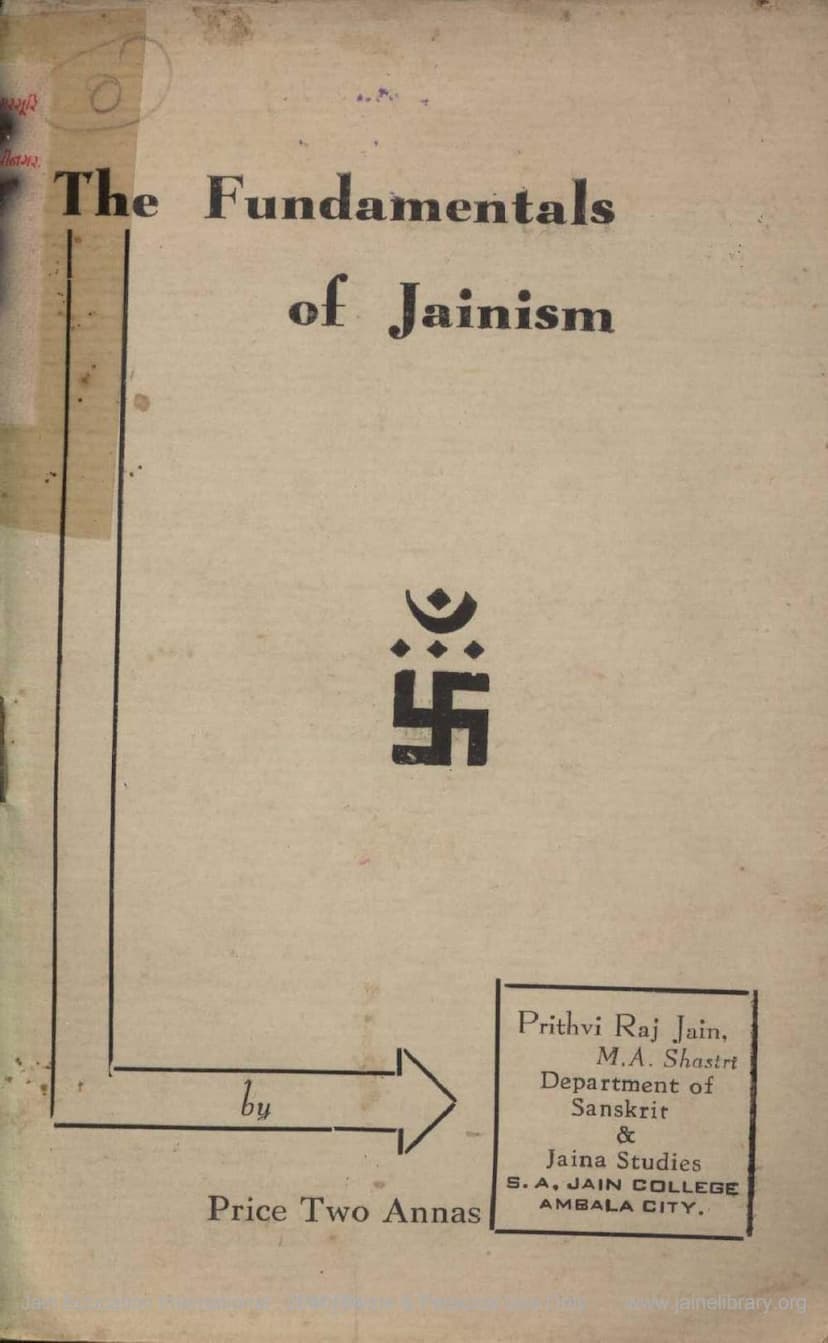Fundamental Of Jainism
Added to library: September 1, 2025

Summary
This document provides a comprehensive introduction to the fundamentals of Jainism, authored by Prithviraj Jain and published in June 1956. The author's aim is to acquaint the educated laity with the core principles of this ancient Indian philosophy and religion.
Key Highlights of the Text:
-
Ancient and Independent Origin: The text strongly refutes the notion that Jainism is a breakaway from Vedic religion or an offshoot of Buddhism. It asserts Jainism's claim to be an eternal truth, revealed by innumerable Tirthankaras (victors or omniscient beings) throughout history. Literary evidence, including references in the Yajurveda and Buddhist literature, is presented to support its antiquity, predating or coexisting with Vedic and Buddhist traditions. The author also highlights its independence from Upanishadic thought.
-
Shramanic Culture: Jainism is positioned as a prominent representative of the ancient Shramanic culture, which is characterized as indigenous, pessimistic in worldly outlook, dualistic or pluralistic in metaphysics, animistic, humane in ethics, ascetic, accepting transmigration and karma, and rejecting the concept of a creator God and Vedic authority. This is contrasted with the Vedic or Brahmanic culture, which is described as based on inequality, while Shramanism is based on equality in society, goals, and treatment of living beings.
-
Distinction from Buddhism: While both Jainism and Buddhism share certain principles like denying Vedic authority, rejecting priestcraft and caste rigidity, deifying the soul, and emphasizing Ahimsa (non-violence), the text points out key differences. These include Buddhism's denial of an eternal soul (believing in a series of states instead) and Jainism's emphasis on external and internal self-denial, contrasting with Buddha's opposition to external austerities. The term "Nirgrantha" (free from fetters) is exclusively associated with Jain monks.
-
No Divine Revelation, Self-Reliance: A foremost peculiarity of Jainism is its claim to have no non-human source. Its tenets are based on the knowledge of perfected beings (Victors) who achieved their state through their own efforts in this universe. Jainism stresses self-reliance, with the human soul being the sole agent of its own purification and liberation. The text quotes Lord Mahavira: "Man, thou art thine own friend..."
-
Metaphysics: Substance and Change: The Jain metaphysical view posits a universe without beginning or end, governed by the inherent powers of substances undergoing changes. Substance is defined by its permanent essential characters (gunas) and changing modes (paryayas). Jainism rejects both absolute impermanence (Buddhism) and absolute permanence (Vedanta), advocating for "permanence in change."
-
Six Substances (Dravyas): The text outlines the six fundamental substances in Jainism:
- Jiva (Soul): The essence of consciousness, eternal, infinite in number, and capable of attaining perfect knowledge and bliss. Souls are either emancipated or worldly, with worldly souls clouded by karma.
- Pudgala (Matter): Subject to integration and disintegration, ending in atoms. It possesses touch, taste, smell, and color.
- Akasha (Space): Provides room for substances, divided into Lokakasha (containing the world) and Alokakasha (empty space).
- Kala (Time): Responsible for modifications and changes.
- Dharma and Adharma: Unique Jain substances that facilitate movement and rest respectively, without causing them.
-
Concept of God: Jainism does not believe in a personal, omniscient, all-powerful creator God. Instead, deified liberated souls (Arhats and Siddhas) take the place of God, serving as guides and inspirations. The text quotes Jawaharlal Nehru's sentiment that human spiritual ascent is more impressive than being a mouthpiece of a divine power. It also highlights the impersonal nature of Jain worship, which reveres all souls worthy of Godhood without discrimination.
-
Navikara Mantra: The recitation of the Navikara Mantra by Jains pays homage to five classes of Supreme Ones: Arhats, Siddhas, Acharyas, Upadhyayas, and Sadhus.
-
Syadvada and Anekantavada: The text introduces Syadvada (the doctrine of "perhaps" or "from a certain point of view") and Anekantavada (the doctrine of non-absolutism or manifoldness of reality). These principles acknowledge that every object has innumerable characters, and human knowledge is relative and partial. Judgments should be qualified to avoid absolute claims and misapprehension, leading to the development of the Saptabhangina ya (seven forms of judgment). Syadvada promotes toleration and intellectual freedom by harmonizing seemingly discordant doctrines.
-
Jain Ethics and Path to Salvation: The ultimate goal in Jainism is Moksha (salvation), which is freedom from the cycle of birth and death. This is achieved through one's own striving via right vision, right knowledge, and right conduct. The path involves practical disciplines, rules of conduct, and penances, with stages of spiritual development called gunasthanas.
-
Monastic and Lay Vows: Jainism prescribes two sets of rules: for monks and nuns (five great vows: non-injury, truthfulness, non-stealing, celibacy, non-attachment) and for householders (Shravakas and Shravikas), which are similar but modified. Lay followers also observe additional vows, such as not eating after sunset and earning a livelihood justly.
-
Karma Doctrine: Karma is understood as a material and subtle substance that binds the soul, causing its bondage. Every action, word, and thought produces transcendental effects that materialize as rewards or punishments. Jainism elaborates on the intricate details of karma, with Dr. L. Glasenapp noting that Jainism teaches karma to be of a concrete, physical nature.
-
Overall Message: The text concludes by stating that Jainism aims to introduce a reign of peace, ordered harmony, and reasonable sweetness in a world characterized by materialism and self-aggrandizement, emphasizing the core principle of Ahimsa (non-violence).
The pamphlet also includes a preface by the author, detailing the inspiration and circumstances surrounding its publication, acknowledging the influence of various Jain scholars and organizations.